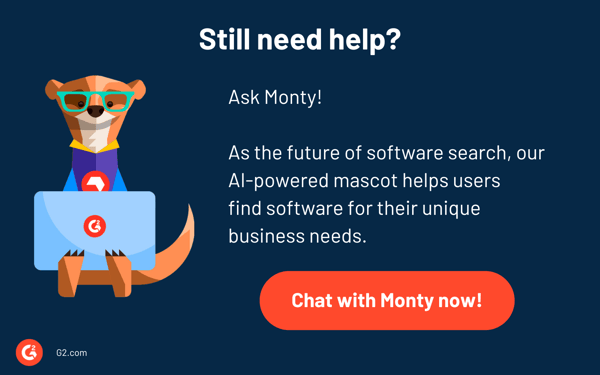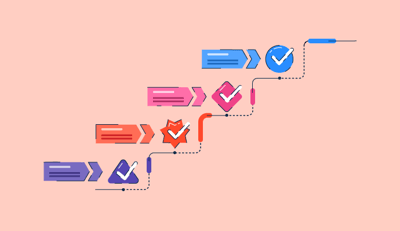
November 3, 2023
 by Mara Calvello
by Mara Calvello

Effective employee-manager communication greatly benefits organizations.
If it isn’t practical, employees won’t feel like their needs are being supported. They won’t work hard to accomplish their strategic goals and objectives to better the company.
Performance management builds strong communication and ensures all employees conduct their roles to the best of their ability. Companies can create effective strategies and workflows using performance management systems and retain historical performance data to track everything easily.
Performance management is a communication tool used to identify, measure, and develop the performance of employees, teams, and departments to support the overall business goals and objectives. It is a continuous practice that incorporates goal-setting, feedback, check-ins, and engagement surveys during employee performance cycles.
Conducting performance management ensures that each employee is actively engaged, growing in their work, and invested in your company’s success for the long haul. When done correctly, performance management begins when a job is defined and ends when that hired employee leaves your organization.
While performance management is typically the role of a manager or department lead, an HR professional should contribute by encouraging managers and supervisors to take responsibility for managing performance within their team and plan for performance improvement across the organization.
Performance management is either formal or informal. Managers can assess employee behavior, conduct, peer feedback, and quality of work. This system has a grading and scoring system based on employees' achievements, performance scale, and feedback mechanism. These features track performance, measure career goals, and map employees' next five or ten-year growth plan.
The system divides the review process into self-review and manager's review. Self-review and manager's review are two sides of the same coin. In the self-review system, employee rates their performance and share learnings.
They assess their key performance indicators(KPIs) of work goals and many targets achieved in a particular quarter. Manager's reviews are based on a critical analysis of the company's return on investment (ROI) generated through employee performance. Managers are responsible for showcasing the dollar value of their employee's efforts and helping them get promoted or receive handsome bonus amounts.
Performance management directly impacts the efficiency and work quotient of a workplace. By running feedback-driven performance reviews, employees get a sense of belongingness and value, which increases their motivation and inspires them to outdo themselves at work. Several departments within a company practice performance management to track performance, run rewards or loyalty programs, and upgrade designations.
Performance management can impact your business significantly, no matter the industry or size of your organization, because it can make or break employee performance and engagement. When performance at a company is well-managed and employees are working at their full potential, organizations reap the rewards.
Because performance management is about understanding and motivating employees to perform while supporting the broader goals of the organization, not only will the company achieve peak performance and reach new heights, employees will do the same.
Employees in every department and within every role will know what's expected of them, motivating them to improve their skills and development and deliver the results needed per their employee success plan.
While some companies think checking in with an employee once or twice a year during a performance appraisal is enough, those who utilize performance management will likely get better results since they can more easily solve what isn't working and double down on what is. Employees will benefit from a continued push to reach their goals and progress rather than rushing to meet objectives once employee performance review season rolls around.
Performance management is about measuring and improving the employee's contribution to the organization and should always be noticed.
Remember that the goal of your employees is to achieve the company mission and vision, along with theirs.
employees want their managers to provide them with proper feedback and opportunities for enhancing their performance level.
Source: Enterprise Apps Today
Performance management is an essential tool that helps employees realize their full potential while assisting management and HR to get the most out of the workforce. Since performance management is a process that aims to bring individual goals together with group and organizational goals, it’s a strategic and formal process.
When building a strategy, here are the standard components you should include.
Employee check-ins have the power to make or break the feedback culture. These casual one-on-one conversations are typically between an employee and manager about the employee’s performance, progress toward their goals, and what they need from their manager to be successful within their role.
Frequency matters when it comes to employee check-ins. They should be performed weekly to create a comfortable tone and to urge an ongoing and evolving conversation. It helps to build a strong feedback culture where employees feel heard rather than managed.
No employee wants to be left in the dark regarding how they’re doing at work – they want to know how they’re performing. Because they want to be sure they’re doing a good job, managers need to communicate with their employees regarding their performance.
Every manager must touch upon employee performance attributes, like:
The more feedback a manager gives to an employee, and vice versa, the better for everyone. Regular one-on-one dialogue between managers and their team members ensures that employees remain informed about their performance throughout the year. This approach nurtures a culture where employees are not only informed but are also continuously motivated to pursue their goals with dedication.
In the context of 2022 U.S. companies, the accompanying graph describes the preferences of different employee types regarding one-on-one interactions. The figure categorizes employees into three groups: onsite, hybrid, and remote.
Part of a well-thought-out performance management strategy will enable SMART (specific, measurable, achievable, relevant, time-bound) goals to be aligned throughout the organization. Goals can be created or cascaded down by managers. The goal management functionality also facilitates the tracking of goal progress.
To drive employee engagement, managers must work to ensure their employees' personal goals align with the organizational goals and that progress toward these goals is part of their regular check-in conversations.
In addition to SMART goals, other types of goals that are a part of performance management include:
One of the most valuable elements of performance management strategies is the 360-degree performance review. This method is when employees are allowed to both receive and give constructive feedback regarding the performance of their peers, managers, and direct reports. It creates a well-rounded view of their performance instead of only receiving feedback top-down from their manager.
It can benefit employees as they better understand their strengths while also providing new development opportunities and where they need additional coaching. These varying perspectives allow employees to get a complete picture of their strengths, weaknesses, and new ways to grow.
Tip: Use performance review templates to structure your feedback and discussion better.
What matters most to your employees? That’s where an employee engagement survey comes in.
As the name suggests, the main reason organizations carry out an employee engagement survey is to discover if employees feel engaged or disengaged. While there’s no right way to measure engagement, you can start by implementing employee engagement software to your company’s tech stack.
Doing so can help organizations solicit and track employee feedback, recognize employee achievements, and promote positive activity.
Some commonly assessed factors within these surveys include:
Aside from measuring engagement, it has the added benefit of
allowing employees to voice their concerns and comment on what is being done well within the company. These results, in turn, highlight areas for improvement and development.
A little recognition and praise can go a long way, and it’s a big part of performance management. Whether you use feedback apps or collaboration tools to empower employees and encourage them to celebrate small successes or announce an employee’s success in a team meeting, they can boost workplace productivity.
Managers should offer recognition and rewards for goals met, values demonstrated, and work well done to keep employees engaged and working toward their organization’s goals.
of employees will stay with a company for longer if it invests in their professional development.
Source: ClearCompany
Now that we’ve clearly understood why performance management is essential and the components you’ll need to include to get it right, let’s break down what the performance management process will look like.
Before the performance manager discussion officially begins, here are some things that managers, supervisors, and HR professionals should be sure to do.
During the performance evaluation, remember to:
Once everything is said and done, below is what you should remember to do after the conversation has come to a close:
Forward all appropriate documentation to the HR department and retain a copy for easy referral during the following performance management discussion.
While managing the performance of a large number of employees sounds difficult, different companies have unique processes and workflows to assess the same.
-png.png?width=600&height=333&name=Copy%20of%20X%20vs%20Y%20vs%20Z%20(13)-png.png)
Performance management is a continuous cycle of prioritization, feedback, and review collection conducted in a company. Managers supervise the performance of their direct reports and maintain a record of individual achievements throughout the year. Consistent performance helps the manager decide who deserves to get promoted in the next round. Every employee's activity is logged and analyzed to determine their future in a particular department or company.
Performance appraisal is a fixed season of employee performance reviews that occurs quarterly, half-yearly, or annually. Also known as the increment cycle, appraisals are a specific hike in overall cost to the company (CTC) that an employee gets. If an employee performs exceptionally well, he can get two or three rounds of appraisals on increment in a single go.
SMART stands for specific, measurable, achievable, relevant, and time-bound. These goals are a part of a performance development plan or PDP that an employee designs to map their career road in a company. These action items are a forecasted contemplation of how work would shape up in the next quarter or before the next appraisal cycle. Each action item or goal is conditioned to scale the personal career trajectory of an employee and secure their future in the company.
Between HR, leadership roles, and C-suite executives, performance management should be top of mind to ensure that employees are aligned with the business to see success on all sides.
Once you have a strategy, it’s time to invest in performance management software to streamline it.
When on the hunt for an application to help your business regulate performance management, look for features like:
Tools that incorporate these features can be used by any business looking to improve and promote the effectiveness of their employees while using a tool that makes it all easy.
When you need an application that can help establish employee performance standards while evaluating an individual’s job performance, then it’s time your organization implements performance management software. Doing so can help your business facilitate meaningful and ongoing discussions between managers and their direct reports.
Typically, these tools are implemented into a tech stack as an easy way to support HR managers as they conduct employee performance reviews, maintain a record of discussion topics, iron out employee goals, and give constructive feedback. They can be a standalone tool or part of an HR management suite.
To be included in this list, software must:
* Below are the top five leading performance management software solutions from G2’s Fall 2023 Grid® Report. Some reviews may be edited for clarity.
Lattice is an easy-to-use people management platform that allows managers to develop engaged and high-performing teams. Lattice makes it simple to share feedback, facilitate one-on-ones, set up goals, administer employee engagement surveys, and so much more.
“I enjoy the Perform module as it contains the critical components an employee needs to chart and track performance, such as goals, one-on-ones, and performance reviews. It also contains a public praise mechanism by which our team can provide continuous feedback, routed directly into our shared Slack channel so everyone can see when someone gets props!”
- Lattice Review, Rebecca A.
"It would be useful to have freeform text updates outside the scope of the weekly update process. For instance, our business is currently operating on quarterly cycles for goal review and creation. At the end of each quarter, we have to use the "weekly update" feature to evaluate progress on all of our goals for that quarter and provide additional information in one place. It's not the world's end, but it would be an excellent addition."
- Lattice Review, Matthew J.
Culture Amp is an all-in-one human capital management solution that can do it all. It offers employee engagement solutions to drive development, increase retention, and bring meaningful changes.
“The new design changes ensure I can support my team in their professional career progression. The way objective setting, feedback, performance reviews, and 1:1 meetings interact with each other makes it easy to track progress, show development opportunities, and give praise. The transparency allows everyone to be on the same page and makes my job easier.”
- Culture Amp Review, Chris H.
“The training contents can be enhanced a little bit more. Managerial content is much more than the ones for employees. The training for managers is cool, and you can catch up on the soul of the time. But for employees, it can be upgraded a little bit more.”
- Culture Amp Review, Gokhan K.
If your company needs a solution that simplifies employee performance and growth tracking by automation while enabling people to become their best selves, go for BambooHR. Managers will have complete visibility surrounding employee performance, OKR tracking, one-on-ones, engagement surveys, and more.
- BambooHR Review, Kristen P.
"I wish the announcements were more customizable. The template is pretty generic - I wish it were more of a true email template like you get with Constant Contact or working in a PDF. It makes our weekly announcements look generic - you can't format the pictures or text very well. I also wish the org chart was more customizable."
- BambooHR Review, Amy M.
HiBob HRIS is an HR platform for modern businesses to help improve employee experiences. It powers productivity, engagement, and retention. It offers personalized recruiting and onboarding, pay, benefits, and career development information.
- HiBib HRIS Review, Jake W.
"The recognition feature (kudos) is very lightweight compared to any other piece of recognition software (can't link recognition to values or specific projects and can't add images, gifs, hashtags.) Despite great security and permission groups at a field level, the Kudos feature is lumped into the Announcements and Polling feature. If you give employees access to Kudos, they also get the ability to send out announcements and polls."
- HiBob HRIS Review, Kim C.
When you need an all-in-one tool that helps HR professionals streamline payroll, workforce management, talent, benefits, and more, look no further than Paylocity. This flexible application makes it easy for its users to tackle even the biggest HR and payroll challenges so that they can focus on the task at hand.
- Paylocity Review, Rachael S.
"One hard thing about Paylocity is that it can be somewhat complicated to learn. However, there are so many trainings available that if you take the time to watch through training videos and dig into Paylocity, you can learn it. I wish there were a way to set up auto-emails for specific things."
- Paylocity Review, Kayleen J.

Performance management is a crucial part of the success of any business. When done correctly, it can ensure that all members of each department are aligned with the objectives of the company and fully understand how they can benefit the organization for the long haul.
If your team works hard and continues to hit goals set out by performance management plans, then consider merit pay for their commitment to improving their performance.

Get the best performance management software to track and establish employee performance standards better.
Mara Calvello is a Content Marketing Manager at G2. She graduated with a Bachelor of Arts from Elmhurst College (now Elmhurst University). Mara's expertise lies within writing for HR, Design, SaaS Management, Social Media, and Technology categories. In her spare time, Mara is either at the gym, exploring the great outdoors with her rescue dog Zeke, enjoying Italian food, or right in the middle of a Harry Potter binge.

Get the best performance management software to track and establish employee performance standards better.
We all have that one area of expertise we wish we were just a little better at.
 by Mara Calvello
by Mara Calvello
Day in and day out, the leaders within your human resources department have a lot on their...
 by Mara Calvello
by Mara Calvello
A new employee has joined your company – hurrah! You spent weeks or longer looking for the...
 by Holly Landis
by Holly Landis
We all have that one area of expertise we wish we were just a little better at.
 by Mara Calvello
by Mara Calvello
A new employee has joined your company – hurrah! You spent weeks or longer looking for the...
 by Holly Landis
by Holly Landis
Never miss a post.
Subscribe to keep your fingers on the tech pulse.


